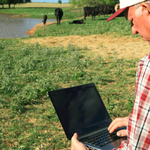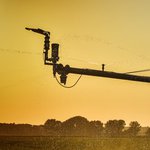Agriculture and the Economy
The Kansas City Fed is a leader on topics related to the agricultural economy within the Federal Reserve System. Our work provides insights on agricultural and rural economies for our seven-state region of the Tenth Federal Reserve District and nationally.
Latest Updates
Disparate Conditions in Crop and Livestock Sectors Evident in Credit Conditions
Agricultural credit conditions in most of the region deteriorated gradually during the third quarter of 2025.
Larger Operating and Livestock Loans Drive Farm Lending Demand
Steady demand for operating and feeder livestock loans boosted farm lending at commercial banks in the third quarter.
Biofuel Policies Are Likely to Drive Future Demand for U.S. Corn and Soybeans
The supply of U.S. corn and soybeans has grown over the past decade and is projected to increase further in the coming years. ...
Farm Debt at Agricultural Banks Continues to Build
Farm debt at commercial agricultural banks continued to grow at a moderate pace in the second quarter.
Weakness in Crop Sector Weighs Further on Farm Finances
Farm income and credit conditions deteriorated steadily throughout the Midwest and plains states in the second quarter of 2025...
Second Quarter Ag Bulletin
Disparities in the U.S. agricultural economy persisted in the second quarter of 2025.
Summit Highlights Factors Influencing Investment in Food Production and Distribution
In June, industry experts met at the Federal Reserve Bank of Kansas City’s Food and Agriculture Economic Summit to discuss...
Fed Listens: Trends in the Agricultural Economy
Federal Reserve Governor Michael Barr joined the Kansas City Fed for a Fed Listens event discussing trends in the agricultural...
Some Segments of the Agricultural Economy Are Particularly Sensitive to Changes in the Foreign-Born
For years, many segments of the U.S. agriculture sector have relied on foreign-born and undocumented workers to meet labor...
Resources on the Ag Economy

Ag Finance Updates
Find articles summarizing recent developments in agricultural finance and lending.

Ag Credit Survey
The quarterly Ag Credit Survey provides current indicators of the financial performance of Tenth District agriculture.

Ag Outlooks
Review the latest Ag Bulletin for a summary of ag conditions and additional outlook articles on the ag economy.

Kansas City Fed Research
Find recent monetary policy, payments system and regional and community research from the Kansas City Fed.
Our Connection to Agriculture
The Federal Reserve Bank of Kansas City has a long history of focus on the U.S. and global agricultural economy. The Tenth Federal Reserve District, which includes Colorado, Kansas, Nebraska, Oklahoma, Wyoming, northern New Mexico and western Missouri, is strongly connected to agriculture, from farm production and food manufacturing to agricultural banking and finance. Because the industry is vital to the region we serve, the Kansas City Fed is committed to understanding developments in the agricultural economy and gathering perspectives from rural America in order to include them in discussions on the national economy.
Recent Research
Ag Finance Updates
-
Volume of New Ag Loans Drops | -
Farm Lending Stabilizes, but Bank Liquidity Tightening | -
Agricultural Lending Increases, As Do Interest Expenses for Farmers | -
As Rates Tick Up, Growth in Operating Loans Boosts Farm Lending | -
Ag Banks Make Adjustments as Lending Remains Elevated | -
Prolonged Need for Lending Pressures Farm Finances |
Ag Credit Survey
-
Agriculture in the Tenth District Feels Initial Effects of Pandemic | -
Regional Farm Sector Stress Intensifies | -
Financial Stress in Farm Sector Shows Slow but Steady Increase | -
Farm Finances Continue to Weaken Amid Ongoing Uncertainty |
Recent Speeches
-
Remarks on the Outlook and Monetary Policy | -
Agriculture and the Federal Reserve | -
Agricultural Research Hub - Update on the U.S. Agricultural Economy |
- Outlook for the U.S. and U.S. Agriculture |
- Farm Economy and Financial Outlook |
